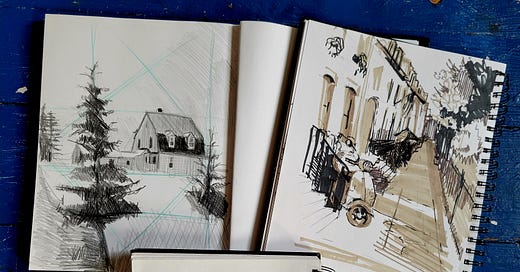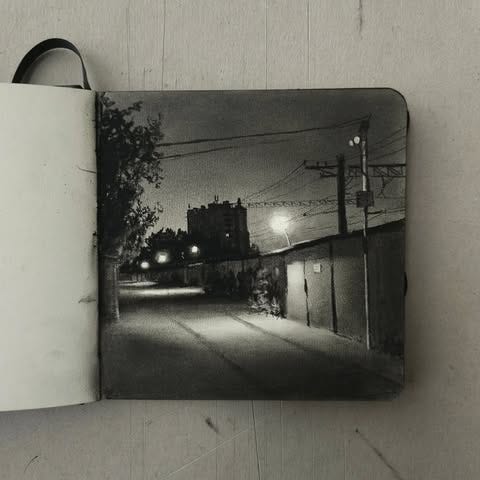An artist friend, Nathan Rutkowski [Website link & IG link], recently asked other artists if they have a daily sketchbook drawing practice. I admire those who do, but I don’t—and I often wonder why not.
I got my first sketchbook in fourth grade while I was home sick with chickenpox. Someone gave me a sketchbook and a set of charcoal pencils, which made me feel like my drawings were important. I struggled with the charcoal and didn’t enjoy the texture of the paper, but that sketchbook became the first place I consistently drew. Inspired by the books I read—Little House on the Prairie and Anne of Green Gables—I filled the pages with scenes of people in landscapes, houses, and fancy clothes.
From that point on, I always kept a sketchbook. Before then, I drew on scraps of paper I found around the house, often drawing on the back of my dad’s sermons. But starting in fourth grade, the sketchbook became my studio—a portable world where I could create.
In those early years, I drew almost daily. I used pencil, colored pencils, ink, watercolor, and eventually gouache, which a neighbor, Bill Landmesser [Link], introduced me to in high school. Another neighbor, Holly Mead [Link], taught me silkscreen printing. While silkscreening didn’t happen in my sketchbook, I planned my prints there. Through high school, all my personal, unassigned artwork lived in my sketchbook, and it served as the starting point for my portfolio pieces when I applied to art school.
In art school, my relationship with sketchbooks changed. My art world expanded as I worked in big studios on large-scale projects, both 2D and 3D. I studied at an academy focused on traditional, realistic techniques like drawing, printmaking, painting, and sculpture. Assignments required finished pieces, so my sketchbook became less central—more of a space for class notes or lists of materials.
Over the years, I struggled with the role of sketchbooks in my practice. For a long time, they felt like a compromise—a tool I used because I couldn’t paint in the moment. Sketches became placeholders or visual notes rather than meaningful explorations. When I felt inspired, I wanted to dive directly into painting or printmaking without preplanning in a sketchbook. I worried that sketching would dilute the initial idea, making it feel overworked or losing something in translation from sketchbook to finished work.
I’ve always loved looking at other artists' sketchbooks, whether in museums or reprinted editions. I remember an excellent exhibit of Laurie Olin’s sketchbooks at the Philadelphia Athenaeum [Link to gallery talk] and enjoy browsing Robert Crumb’s [Link] and David Park’s [Link] sketchbooks. These show the thought processes of artists and, in some cases, how sketches informed finished works. Social media, especially Instagram, introduced me to another perspective: sketchbooks as curated, polished art objects—diaries of creative lives that doubled as portable personal museums.
In recent years, I’ve come to see my sketchbook differently. It’s not just a fallback but a tool that actively improves my paintings. When painting outdoors, I often feel overwhelmed by the countless possibilities in the landscape. My sketchbook helps me narrow down my focus, identify the best view, or solve problems like challenging perspectives. I’m learning to treat it as a space for experimentation, practice, and exploration rather than a lesser substitute for painting.
While my sketchbooks may never be polished art objects, they’ve become essential to my process. They’ve evolved from private, unfinished spaces to integral parts of my practice. This shift has helped me grow as an artist, giving me a place to take risks, make mistakes, and develop ideas that directly inform my finished works.
Some examples of the curated sketch book:
Also see Austin Kleon Substack [Link]
I’ve started sharing occasional sketches on Instagram and recently developed a class at Main Line Art Center on using the sketchbook as part of the painting process. I realized that if moving from sketching to painting was a challenge for me, it might be for other artists too. The class explores how a sketchbook can support the creative process, helping bridge the gap between planning and execution.
What does your sketchbook mean to you? Do you draw daily? Or has your relationship with it evolved like mine?
For upcoming classes in the Philadelphia area follow this link.









I keep a few! They feel like my most honest raw ideas and I use them more like information about myself, but I have never considered how they can be like portable museums and that makes me appreciate the artists who make really detailed ones.
This post was super helpful. I too struggle with my sketchbook practice. Learning how you use yours gives me inspiration!